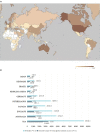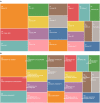International Publication Trends in Low Back Pain Research: A Bibliometric and Visualization Analysis
- PMID: 35309209
- PMCID: PMC8926158
- DOI: 10.3389/fpubh.2022.746591
International Publication Trends in Low Back Pain Research: A Bibliometric and Visualization Analysis
Abstract
Background: Although there is a growing research base on low back pain, the bibliometric literature related to it is deficient. The aim of this study was to conduct a bibliometric and visualization analysis of low back pain and to provide a broad view of the current trends in LBP research and a potential guide in this discipline.
Methods: The authors searched the Web of Science to extract publications regarding low back pain, and found a total of 12,249 publications during a period of 22 years, among which 12,242 were eligible. We classified and analyzed publications such as total citations, average citations per item, H-index, research types, countries/regions, institutions, and journals using standard bibliometric indicators. Bibliometric approaches (VOSviewer1.6.13 and CiteSpace 5.8.3) were also available for gathering information and explore the trends of research.
Results: Conspicuously, over the past 22 years, an increasing number of scholars have specialized in the research of LBP, exerting the boom in articles. The largest number of document type was that of articles. Under modern conditions, regional distinction existed in the research of low back pain and developed countries preceded others. Research individuals and institutions were preoccupied by respective aspects. Visualization analysis provided objective information for potential collaborators and cooperative institutions. Furthermore, most burst keywords varied during different periods.
Conclusions: The map of research on LBP obtained by our analysis is expected to help researchers to efficiently and effectively explore LBP.
Keywords: bibliometric analysis; low back pain; publications; trend; visualization.
Copyright © 2022 Huang, Zheng, Wu, Zhao, Xu, Li, Huang, Fan and Wu.
Conflict of interest statement
The authors declare that the research was conducted in the absence of any commercial or financial relationships that could be construed as a potential conflict of interest.
Figures








Similar articles
-
Trends of Low Back Pain Research in Older and Working-Age Adults from 1993 to 2023: A Bibliometric Analysis.J Pain Res. 2023 Oct 2;16:3325-3341. doi: 10.2147/JPR.S425672. eCollection 2023. J Pain Res. 2023. PMID: 37808461 Free PMC article. Review.
-
Knowledge Mapping Analysis of International Research on Acupuncture for Low Back Pain Using Bibliometrics.J Pain Res. 2021 Dec 7;14:3733-3746. doi: 10.2147/JPR.S340992. eCollection 2021. J Pain Res. 2021. PMID: 34916841 Free PMC article.
-
A bibliometric analysis of self-efficacy in low back pain from 1980 to 2021.Pain Pract. 2023 Apr;23(4):378-389. doi: 10.1111/papr.13201. Epub 2022 Dec 28. Pain Pract. 2023. PMID: 36541115
-
Study of acupuncture for low back pain in recent 20 years: a bibliometric analysis via CiteSpace.J Pain Res. 2017 Apr 24;10:951-964. doi: 10.2147/JPR.S132808. eCollection 2017. J Pain Res. 2017. PMID: 28479858 Free PMC article.
-
Study on Pain Catastrophizing From 2010 to 2020: A Bibliometric Analysis via CiteSpace.Front Psychol. 2021 Dec 17;12:759347. doi: 10.3389/fpsyg.2021.759347. eCollection 2021. Front Psychol. 2021. PMID: 34975649 Free PMC article. Review.
Cited by
-
Thirty-year survey of bibliometrics used in the research literature of pain: Analysis, evolution, and pitfalls.Front Pain Res (Lausanne). 2023 Mar 1;4:1071453. doi: 10.3389/fpain.2023.1071453. eCollection 2023. Front Pain Res (Lausanne). 2023. PMID: 36937565 Free PMC article. Review.
-
Top 100 most-cited articles on hemorrhoids: A bibliometric analysis and visualized study.Front Surg. 2022 Nov 11;9:1021534. doi: 10.3389/fsurg.2022.1021534. eCollection 2022. Front Surg. 2022. PMID: 36439542 Free PMC article.
-
Global cluster analysis and network visualization in organoids in cancer research: a scientometric mapping from 1991 to 2021.Front Oncol. 2023 Sep 15;13:1253573. doi: 10.3389/fonc.2023.1253573. eCollection 2023. Front Oncol. 2023. PMID: 37781203 Free PMC article.
-
Trends of Low Back Pain Research in Older and Working-Age Adults from 1993 to 2023: A Bibliometric Analysis.J Pain Res. 2023 Oct 2;16:3325-3341. doi: 10.2147/JPR.S425672. eCollection 2023. J Pain Res. 2023. PMID: 37808461 Free PMC article. Review.
-
Research status and hotspots of medication safety in older adults: A bibliometric analysis.Front Public Health. 2023 Jan 5;10:967227. doi: 10.3389/fpubh.2022.967227. eCollection 2022. Front Public Health. 2023. PMID: 36684998 Free PMC article. Review.
References
Publication types
MeSH terms
LinkOut - more resources
Full Text Sources
Miscellaneous

